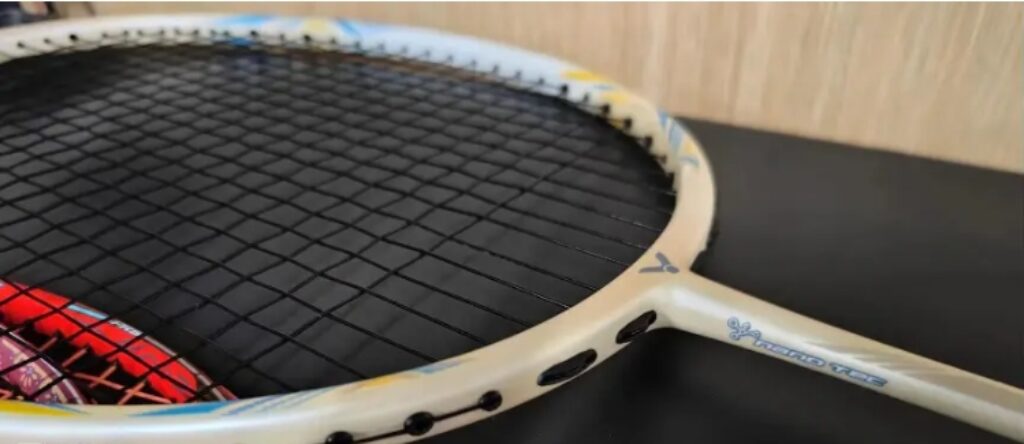Recently, the Blue Factory has released many new low-end, mid-range, and sub-high-end models. Unlike the previous wave of rackets that seemed to simply swap in a floating handle on existing models, many of the new models this time don’t seem to have prototypes in the current lineup.
Except for the 10M, the Yu series has continued to remain low-profile. However, the new quarter’s Yu F/M series has finally garnered some attention, at least in the promotions. Meanwhile, the Yu 5H has reappeared in the spotlight due to player reviews and retailers clearing their stock. But in an unassuming corner, there’s also a new Yu 3H…

Specifications: 4UG5, with a bottom cap, total weight in use is 90.33g, balance point 295mm, shaft length 210mm, stiffness is medium-high, hexagonal aerodynamic frame, 76-hole string bed, 9-3 o’clock string grooves, 30 lbs string warranty, strung at 27-29 lbs with VS100.
The Yu 3H has an elegant light gold exterior, and the blue and yellow lines on the wings of the frame transition to a beige design, giving the racket a fresh look. Aside from these painted details, the racket has no other decals, making it appear even cleaner. The original 3F was a very aesthetically pleasing racket targeted at women, while the 3H is much more neutral in comparison. Both 3F and 3H use the same level of carbon fiber, but upon investigation, it was found that the 3H has had changes in the shaft and handle.
I have never been fond of rackets with FRS, as they tend to give poor feedback from the racket face. However, the low string tension of the 3F was also a downside. The 3H is no exception. With moderate swing weight and relatively high swing speed, the power feels good, but the overall hitting sensation is average. When hitting actively, the floating handle does provide decent shock absorption with high-tension strings, but the filtered feedback makes it harder to generate the desire to hit harder.

Additionally, the racket itself is slightly stiff, but the driving sensation is still fairly easy to control. For the entry-level players this racket is aimed at, while it’s not overly forgiving, it also doesn’t pose much of a problem.

In terms of offense, this is a racket that gives me half a sense of relief. Compared to the 3F, the more solid hitting sensation and greater rebound ability elevate the feel during powerful or sharp smashes to a higher level. The shuttle comes off the racket faster, and generating power is equally enjoyable. However, compared to the 5H, the reduced swing weight and downgraded materials create a significant performance gap when driving the shuttle downward. Therefore, the 3H is more of a racket that emphasizes generating downward power through your own effort. As a result, when my stamina declines or I don’t want to play too aggressively, I actually prefer the slightly heavier and bulkier 5H to maintain control and dominance on the court. This is definitely a racket I would use with high-tension strings, and if it weren’t for the VS100 strings, the situation would be even better. But there is still a considerable difference in offensive efficiency and overall feel between the 3H and 5H.
The aspect of the 3H I’m most satisfied with is its excellent continuity. Its flexibility is similar to the 3F, but it has the fastest shuttle response of the three, which gives the 3H an advantage in fast exchanges in the front and mid-court. Additionally, its higher string warranty supports players with mature short power techniques and awareness, allowing for fast drives and blocks that are tight and seamless.

However, the racket’s feel for controlling small shots is relatively weaker compared to the other two. The Yu 5, with its more stable and solid feel, is at a higher level, and the slight ball-holding sensation of the 3F provides a unique advantage in handling deceptive shots and increasing fault tolerance. In comparison, the 3H appears rather average.
When it comes to handling defensive shots, the 3F remains the best. Its lightweight and slightly softer frame allow for easy returns to the backcourt with just the natural elasticity, without needing to exert much power. It also excels at lifting smashes with ease. While the 5H is slightly heavier, it provides stability and adequate shock absorption, instilling confidence when transitioning from defense to offense. The 3H, at this point, sits somewhere in between the two, lacking distinct characteristics.

From the overall performance of the 3H, it stands out with clear differentiation.
What initially attracted me to this racket was its appearance and the significance of the “H” suffix. After using this product, I was quickly reminded of the old HX60H, and the two indeed have some comparability. However, mid-range balance rackets from the Blue Factory often end up relatively unnoticed, with only the Nano 6/7 series becoming a hit in the past 30 years.

Although I quite like this racket, the awkward part is that the 3H, as a core model in the Yu series, has the same low market presence as the overlooked 3F targeted at women. In terms of performance, the 5H, along with the slightly adjusted and reissued 6/7SP, as well as the higher-end Nano 6/7, are significantly better with just a bit more budget. From the channels I’ve checked, you can get a racket that’s a couple of levels higher in both frame and shaft performance, reaching high-end quality, if you just increase the budget slightly. Therefore, the purchasing advice is clear: “Go for the upgrade.”

Leave a Reply